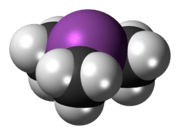Trimethylstibine
 | |
 | |
| Names | |
|---|---|
| Systematic IUPAC name
Trimethylstibane[1] | |
| Identifiers | |
| 594-10-5 | |
| ChemSpider | 11166 |
| EC Number | 209-824-7 |
| Jmol interactive 3D | Image |
| MeSH | trimethylantimony |
| PubChem | 11656 |
| |
| |
| Properties | |
| C 3SbH 9 | |
| Molar mass | 166.86 g mol−1 |
| Appearance | Colourless liquid |
| Density | 1.523 g cm−3 (at 15°C) |
| Melting point | −62 °C (−80 °F; 211 K) |
| Boiling point | 81 °C (178 °F; 354 K) |
| Thermochemistry | |
| Std enthalpy of formation (ΔfH |
24-26 kJ mol−1 |
| Std enthalpy of combustion (ΔcH |
-2.896--2.946 MJ mol−1 |
| Related compounds | |
| Related compounds |
Trimethylamine Trimethylphosphine Trimethylarsine Triphenylstibine |
| Except where otherwise noted, data are given for materials in their standard state (at 25 °C [77 °F], 100 kPa). | |
| | |
| Infobox references | |
Trimethylstibine is a chemical compound with the formula Sb(CH3)3. It is a colorless pyrophoric and toxic liquid.[2] It is produced by anaerobic bacteria in antimony-rich soils.[3] Unlike trimethylphosphine, trimethylstibine is only a very weak Lewis base.
References
- ↑ "trimethylantimony - PubChem Public Chemical Database". The PubChem Project. USA: National Center for Biotechnology Information. 26 March 2005. Descriptors Computed from Structure. Retrieved 25 September 2011.
- ↑ Wiberg, Nils; Wiberg, Egon; Holleman, A. F. (2001), Inorganic Chemistry, Academic Press, p. 766, ISBN 0-12-352651-5, retrieved 2009-07-17
- ↑ Craig, P. J. (2003), Organometallic Compounds in the Environment (2 ed.), Wiley and Sons, p. 295, ISBN 978-0-471-89993-8, retrieved 2009-07-17
This article is issued from Wikipedia - version of the Tuesday, July 07, 2015. The text is available under the Creative Commons Attribution/Share Alike but additional terms may apply for the media files.